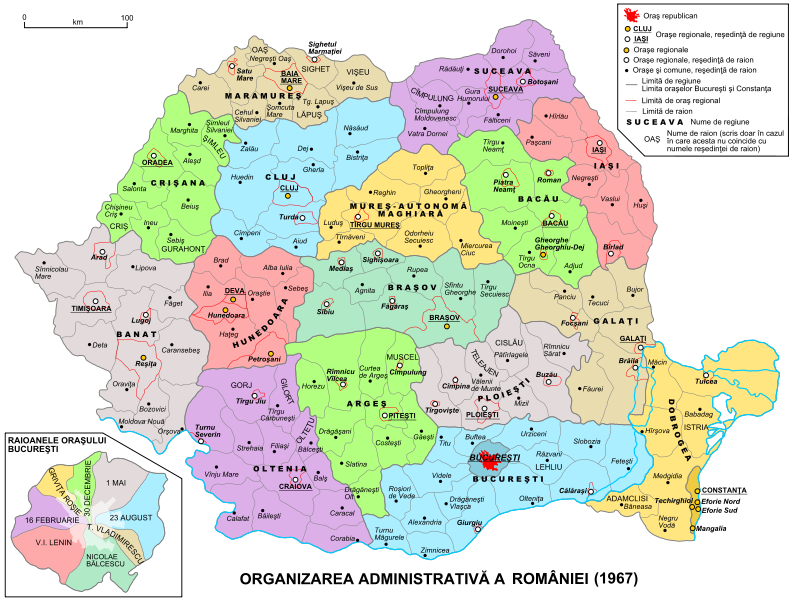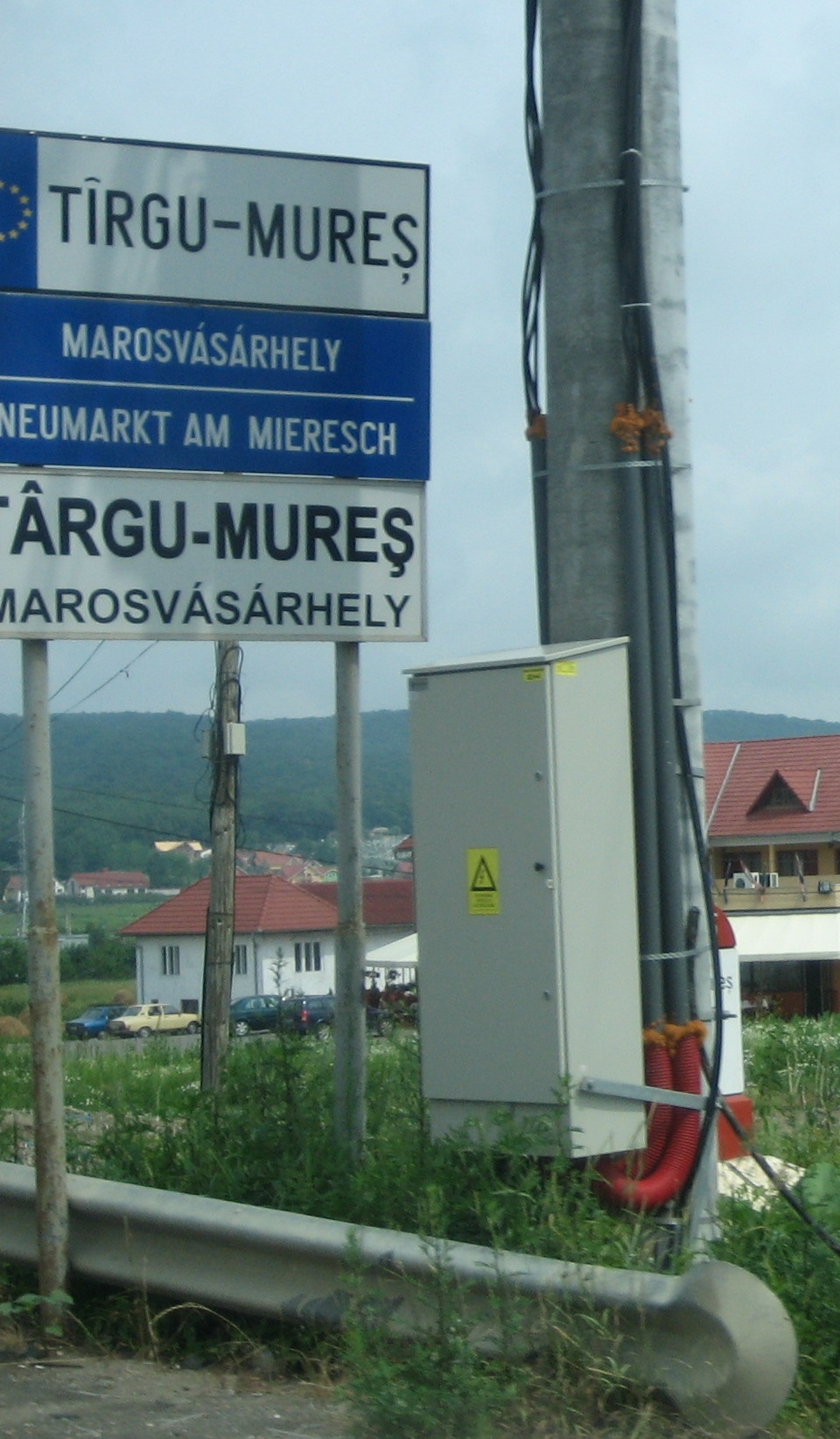|
Hungarian Autonomous Region
The Magyar Autonomous Region (1952–1960) ( Romanian: ''Regiunea Autonomă Maghiară'', Hungarian: ''Magyar Autonóm Tartomány'') and Mureș-Magyar Autonomous Region (1960–1968) were autonomous regions in the Romanian People's Republic (later the Socialist Republic of Romania). History In 1950, Romania adopted a Soviet-style administrative and territorial division of the country into regions and raions (until then, Romania had been divided into ''județe'' or counties). Two years later, in 1952, under Soviet pressure, the number of regions was reduced and by comprising ten raions from the former Mureș Region and from the Stalin Region (both of them created in 1950), of the territory inhabited by a compact population of Székely Hungarians, a new region called the Magyar Autonomous Region was created. According to the 1956 census, the total population of the region was 731,361, distributed among the ethnic groups as follows: Hungarians (77.3%), Romanians (20.1%) ... [...More Info...] [...Related Items...] OR: [Wikipedia] [Google] [Baidu] |
Regions Of The RPR
The regions represented the result of a Soviet Union, Soviet-inspired experiment regarding the administrative and territorial organisation of the Romanian People's Republic (later Socialist Republic of Romania) between 1950 and 1968. See also: Administrative divisions of the People's Republic of Romania. Regions of 1950 *Regiunea Arad (Ar.) *Regiunea Argeș (Ptș.) *Regiunea Bacău (Bc.) *Regiunea Baia Mare (B.Mr.) *Regiunea Bârlad (Bd.) *Regiunea Bihor (Ord.) *Regiunea Botoșani (Bt.) *Regiunea București (R.B.) *Regiunea Buzău (Bz.) *Regiunea Cluj (Clj.) *Regiunea Constanța (Cța.) *Regiunea Dolj (Cv.) *Regiunea Galați (Gl.) *Regiunea Gorj (Tg.J.) *Regiunea Hunedoara (Dv.) *Regiunea Ialomița (Cl.) *Regiunea Iași (Iș.) *Regiunea Mureș (Tg.M.) *Regiunea Ploiești, Regiunea Prahova (Pl.) *Regiunea Putna (Fș.) *Regiunea Rodna (Btr.) *Regiunea Satu Mare (St.M.) *Regiunea Severin (Lgș.) *Regiunea Sibiu (Sb.) *Regiunea Stalin (O.S.) *Regiunea Suceava (Sv.) *Regiunea Teleorman ... [...More Info...] [...Related Items...] OR: [Wikipedia] [Google] [Baidu] |
Romanians
The Romanians ( ro, români, ; dated exonym ''Vlachs'') are a Romance languages, Romance-speaking ethnic group. Sharing a common Culture of Romania, Romanian culture and Cultural heritage, ancestry, and speaking the Romanian language, they live primarily in Romania and Moldova. The Demographic history of Romania#20 October 2011 census, 2011 Romanian census found that just under 89% of Romania's citizens identified themselves as ethnic Romanians. In one interpretation of the 1989 census results in Moldova, the majority of Moldovans were counted as ethnic Romanians.''Ethnic Groups Worldwide: A Ready Reference Handbook By'' David Levinson (author), David Levinson, Published 1998 – Greenwood Publishing Group.At the time of the 1989 census, Moldova's total population was 4,335,400. The largest nationality in the republic, ethnic Romanians, numbered 2,795,000 persons, accounting for 64.5 percent of the population. Source U.S. Library of Congress "however it is one interpreta ... [...More Info...] [...Related Items...] OR: [Wikipedia] [Google] [Baidu] |
Mureș (river)
The Mureș (; hu, Maros, ; sr, script=Cyrl, Мориш, Moriš) is a river in Eastern Europe. Its drainage basin covers an area of .Analysis of the Tisza River Basin 2007 IPCDR It originates in the Hășmașu Mare Range in the Eastern , |
Cluj Region
Regiunea Cluj (Cluj Region) was one of the administrative divisions of the People's Republic of Romania, established on September 6, 1950 by Law nr. 5, and set after the Soviet style. History The capital of the region was the city of Cluj, and at first, its territory comprised an area slightly smaller than the nowadays Cluj and Sălaj counties. On September 19, 1952, the administrative regions of Romania were reorganized by Decree nr. 331. The Cluj Region assimilated the southern raion of the dissolved Rodna Region and a rayon from the reorganised Mureș Region, reaching an area slightly smaller than nowadays Cluj, Sălaj, and Bistrița-Năsăud counties. In 1960 it lost two rayons to the reorganized Magyar Autonomous Region. Neighbors The Cluj Region had as neighbors: *1950–1952: East: Rodna Region and Mureș Region; South: Hunedoara Region and Arad Region; West: Bihor Region; North: Baia Mare Region. *1952–1960: East: Suceava Region and Magyar Autonomous Re ... [...More Info...] [...Related Items...] OR: [Wikipedia] [Google] [Baidu] |
Dennis Deletant
Dennis Deletant (born 5 March 1946) is a British-Romanian historian of the history of Romania. As of 2019, he is Visiting Ion Rațiu Professor of Romanian Studies at Georgetown University and Emeritus Professor of Romanian Studies at the UCL School of Slavonic and East European Studies (SSEES). He is the author of numerous works on the history of Romania including ''Ceaușescu and the Securitate: Coercion and Dissent in Romania, 1965-89'' (London; New York, 1996); ''Romania under Communist Rule'' (Bucharest, 1998); ''Communist Terror in Romania: Gheorghiu-Dej and the Police State, 1948-1965'' (London; New York, 1999); and ''Ion Antonescu: Hitler's Forgotten Ally'' (London: New York, 2006). Deletant had been ''persona non grata'' in Ceaușescu's Romania, but on 31 December 1989, in the immediate aftermath of the Romanian Revolution—there was still some sniper fire, etc.—Deletant entered Romania at Giurgiu as the only Romanian-language speaker in a BBC crew coming in from Bul ... [...More Info...] [...Related Items...] OR: [Wikipedia] [Google] [Baidu] |
Romanian Communist Party
The Romanian Communist Party ( ro, Partidul Comunist Român, , PCR) was a communist party in Romania. The successor to the pro-Bolshevik wing of the Socialist Party of Romania, it gave ideological endorsement to a communist revolution that would replace the social system of the Kingdom of Romania. After being outlawed in 1924, the PCR remained a minor and illegal grouping for much of the interwar period and submitted to direct Comintern control. During the 1920s and the 1930s, most of its activists were imprisoned or took refuge in the Soviet Union, which led to the creation of competing factions that at times came in open conflict. That did not prevent the party from participating in the political life of the country through various front organizations, most notably the Peasant Workers' Bloc. During the mid 1930s, as a result of the purges against the Iron Guard, the party was on the road to achieving power, but this was crushed by the dictatorship of king Carol II. In the perio ... [...More Info...] [...Related Items...] OR: [Wikipedia] [Google] [Baidu] |
Bilingual Sign
A bilingual sign (or, by extension, a multilingual sign) is the representation on a panel (sign, usually a traffic sign, a safety sign, an informational sign) of texts in more than one language. The use of bilingual signs is usually reserved for situations where there is legally administered bilingualism (in bilingual regions or at national borders) or where there is a relevant tourist or commercial interest (airports, train stations, ports, border checkpoints, tourist attractions, international itineraries, international institutions, etc.). However, more informal uses of bilingual signs are often found on businesses in areas where there is a high degree of bilingualism, such as tourist venues, ethnic enclaves and historic neighborhoods. In addition, some signs feature synchronic digraphia, the use of multiple writing systems for a single language. Bilingual signs are widely used in regions whose native languages do not use the Latin alphabet (although some countries like Spain ... [...More Info...] [...Related Items...] OR: [Wikipedia] [Google] [Baidu] |
Irredentism
Irredentism is usually understood as a desire that one state annexes a territory of a neighboring state. This desire is motivated by ethnic reasons (because the population of the territory is ethnically similar to the population of the parent state) or by historical reasons (because the territory formed part of the parent state before). However, difficulties in applying the concept to concrete cases have given rise to academic disputes about its precise definition. Disagreements concern whether either or both ethnic and historical reasons have to be present, whether non-state actors can also engage in irredentism, and whether attempts to absorb a full neighboring state are also included. Various scholars discuss different types of irredentism. One categorization distinguishes between cases in which the parent state exists before the conflict and cases in which a new parent state is formed by uniting an ethnic group spread across several countries. Another distinction concerns wheth ... [...More Info...] [...Related Items...] OR: [Wikipedia] [Google] [Baidu] |
1952 Constitution Of Romania
Year 195 ( CXCV) was a common year starting on Wednesday (link will display the full calendar) of the Julian calendar. At the time, it was known as the Year of the Consulship of Scrapula and Clemens (or, less frequently, year 948 ''Ab urbe condita''). The denomination 195 for this year has been used since the early medieval period, when the Anno Domini calendar era became the prevalent method in Europe for naming years. Events By place Roman Empire * Emperor Septimius Severus has the Roman Senate deify the previous emperor Commodus, in an attempt to gain favor with the family of Marcus Aurelius. * King Vologases V and other eastern princes support the claims of Pescennius Niger. The Roman province of Mesopotamia rises in revolt with Parthian support. Severus marches to Mesopotamia to battle the Parthians. * The Roman province of Syria is divided and the role of Antioch is diminished. The Romans annexed the Syrian cities of Edessa and Nisibis. Severus re-establish his he ... [...More Info...] [...Related Items...] OR: [Wikipedia] [Google] [Baidu] |
Târgu Mureș
Târgu Mureș (, ; hu, Marosvásárhely ) is the seat of Mureș County in the historical region of Transylvania, Romania. It is the List of cities and towns in Romania, 16th largest Romanian city, with 134,290 inhabitants as of the 2011 Romanian census, 2011 census. It lies on the Mureș (river), Mureș River, the second longest river in Romania (after the Danube). Names and etymology The current Romanian language, Romanian name of the city, ''Târgu Mureș'', is the equivalent of the Hungarian language, Hungarian ''Marosvásárhely'', both meaning "market on the Mureș (river), Mureș (Maros) [River]". ''Târg'' means "market" in Romanian and ''vásárhely'' means "marketplace" in Hungarian. Local Hungarians often shorten ''Marosvásárhely'' to ''Vásárhely'' in speech. The Society of Jesus, Jesuit priest Martin Szentiványi provides the first known written reference naming the city; in his work ''Dissertatio Paralipomenonica Rerum Memorabilium Hungariae'' (written in 1699 ... [...More Info...] [...Related Items...] OR: [Wikipedia] [Google] [Baidu] |




